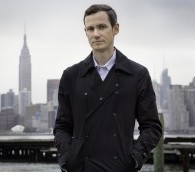Tag: History Travel
The Accidental Hitchhiker
by Celeste Brash | 08.14.15 | 10:26 AM ET
In Samoa, Celeste Brash gave a ride to a man she didn't know. Their encounter will stay with her forever.
A Bridge Not Too Far
by Peter Ferry | 03.01.14 | 1:25 PM ET
On a sunny summer day, novelist Peter Ferry bikes to a Dutch bridge where hundreds of soldiers perished
Interview with Brendan I. Koerner: Love and Terror in ‘The Skies Belong to Us’
by Eva Holland | 07.02.13 | 10:40 AM ET
In the late 1960s and early 1970s, hijackings in American skies were routine. Eva Holland talks to the author of a new book about one young couple's wild long-distance heist.
Old Guidebook, New Life
by Doug Mack | 04.02.12 | 10:52 AM ET
In an excerpt from "Europe on 5 Wrong Turns a Day," Doug Mack envisions a new future for himself in a vintage guidebook
Interview with Doug Mack: ‘Europe on 5 Wrong Turns a Day’
by Leif Pettersen | 04.02.12 | 10:50 AM ET
Leif Pettersen talks to the author about his new book, travel snobbery, and traveling with "Europe on Five Dollars a Day"
R.I.P. Chelsea Hotel
by Eva Holland | 08.22.11 | 11:02 AM ET
The Daily Mail reports that the iconic New York City hotel is no longer accepting new guests, and that its remaining long-term residents are “resigned to being bought out to make way for a run-of-the-mill boutique hotel” now that a new developer has taken control of the site. It’s a sad end for a notorious building. Tom Leonard looks back on the Chelsea’s more than 100 years:
Surely no other single building can lay claim to so much creativity, destruction and sheer scandal as the Chelsea Hotel in New York. For decades it was a byword for Bohemian eccentricity and hellraising excess, an imposing but squalid sanctuary for writers and artists too penniless or troublesome to live anywhere else.
Jack Kerouac wrote his Beat Generation bible On The Road there, in one drug-fuelled, three-week marathon. Arthur C. Clarke wrote 2001: A Space Odyssey there, too, training his telescope not into space but at the apartment windows opposite… From writers such as Mark Twain, Tennessee Williams and Eugene O’Neill, through the hippies and on to the nihilist punks of the 1970s and beyond, ‘the Chelsea’ has more than lived up to its understated description of itself as a ‘rest stop for rare individuals’.
(Via Sophia Dembling)
Bad ‘Carma’
by David Farley | 08.11.11 | 12:43 AM ET
David Farley wanted to drive only occasionally during his stay in Italy. So why did something always go wrong?
Our Own Apocalypse Now
by Haley Sweetland Edwards | 03.07.11 | 1:08 PM ET
From a football stadium in Seattle to a sweaty nightclub in Saigon, Haley Sweetland Edwards wrestles with the f*cked up magic of war
Nine of the World’s Oldest Maps, in Photos
by Eva Holland | 11.16.10 | 12:35 PM ET
Over at the Matador Network, World Hum contributor Lola Akinmade puts together a photo essay of some seriously vintage maps—from ancient Babylon to the Ming Dynasty.
Retracing Paul Theroux’s ‘The Old Patagonian Express’
by Jim Benning | 11.04.10 | 2:10 PM ET
My favorite Paul Theroux book is The Old Patagonian Express, in which he chronicled his journey by train through the Americas. Theroux had a grand time, enduring irritating travelers, witnessing a soccer riot in El Salvador and reading to the late blind Argentine writer Jorge Luis Borges.
So I was happy to hear the other day from Rachel Pook, who is retracing the route Theroux followed in the book—at least from Costa Rica southward—and blogging about it.
As she explains on her site:
An urge for adventure teamed with huge admiration for Paul Theroux’s travel writing has led me to this project.
After seven years working at News International for The Times I decided to escape the confines of Fortress Wapping and do some exploring.
She embarked on the trip in August. Her last post, on Sunday, titled Altitude Sickness and a Tortoise, was from Peru.
The Birthplaces Road Trip
by Chris Epting | 10.20.10 | 9:55 AM ET
From the Google garage to the future birthplace of James T. Kirk, Chris Epting goes looking for the spark of invention
See the full audio slideshow: »
Let Us Now Praise Tour Guides
by Tom Swick | 10.18.10 | 2:29 PM ET
Here's to the men and women willing to go off script
The Titanic: ‘Stories Without Lessons’
by Eva Holland | 10.12.10 | 2:03 PM ET
The Smart Set’s Morgan Meis shares a few of the stories that continue to, er, surface from the Titanic nearly a century after its sinking, and contemplates the ship’s enduring ability to generate narrative:
It would seem that Titanic was more of a giant floating (and sinking) narrative-machine than a boat. Even today, the basic plotline is difficult to believe. Largest ship ever built, filled to the gills with notable names of the time, sinks on its maiden voyage. It takes a few hours for the boat to go under and about a third of the passengers are saved on the insufficient lifeboats, thereby guaranteeing that so much will have happened in the final hours, and so many will have witnessed it, that the world will talk about it for generations. We have.
The most compelling aspect of Titanic, to me, is the degree to which it multiplies stories without lessons. It is, of course, tempting to draw out a lesson about hubris from Titanic, and many have made the mistake of trying to do so. Here is man, challenging nature and the gods with a vessel that would tame the seas, and with beautiful carved mahogany interiors to boot. This behemoth proclaimed itself invincible, unsinkable, and then promptly went under at the hands of a silent and dumb chunk of ice. If frozen water could laugh, there’d have been some icy chuckling in the North Atlantic that night.
Meis goes on to debunk the hubris narrative. It’s a good read.
(Via The Daily Dish)
‘Is Civil War Tourism Fun?’
by Eva Holland | 10.05.10 | 1:41 PM ET
This coming spring marks the 150th anniversary of the onset of the Civil War. John Swansburg, anticipating an upsurge in Civil War tourism as a result, is getting out ahead of the pack—and he’s documenting his jam-packed ten-day Civil War road trip in a series of dispatches for Slate. He begins the trip with a series of questions:
Over the next four years, scores of fathers will use the sesquicentennial celebration as an excuse to don their safari shirts and trundle forbearing wives and irritable children off to Gettysburg or Spotsylvania or Chickamauga. What will they see? Will they learn something they couldn’t have picked up from watching Ken Burns or reading Battle Cry of Freedom? Can visiting these places turn a layman into a buff? Is Civil War tourism fun?
‘Departure is a Central Fact of Ascension Life’
by Eva Holland | 10.05.10 | 11:08 AM ET
The Economist offers up this compelling five-part series from Ascension Island, a remote British overseas territory located just south of the Equator, in the middle of the Atlantic. Part one explains the ways in which Ascension has drifted back and forth, over the years, from being a useful mid-point to being “on the way to nowhere”:
Ascension Island turns on its head the old sailors’ folklore about islands that move from place to place. It sits still, but the world shifts around it in a way that sometimes, unexpectedly, put Ascension Island between an A and a B that people want to get to. Such a realignment happened at the onset of the Falklands war; similar ones have shaped the island’s whole history.
Discovered in 1501 by the Portuguese, Ascension Island was on the way to nowhere and deemed uninhabitable, so it was left uninhabited, most of the time, for centuries to come, though goats were introduced to give anyone with the misfortune of being ship wrecked something to eat. Then in 1815 the British decided to exile the most important man in the world, Napoleon, to St Helena, further south in the Atlantic. Now the island was on the way back to Europe from St Helena, and it was pre-emptively garrisoned lest it be used by vile Buonapartists to ease his escape. After Buonaparte died in 1821, it took on a new role as a base for the navy’s actions against the Atlantic slave trade. As the garrison developed better (though still meagre) water supplies, and gained expertise in the slaughter of turtles, deemed a delicacy, ships on the way back from the Indian Ocean called in more often; the way the trades blow mean that while Ascension is not on a sailing ship’s way from Europe to India, it is on the way back.
(Via The Daily Dish)
Mexico: Celebrating 200 Years of Independence
by World Hum | 09.15.10 | 10:07 AM ET
Mexico marks its bicentennial this week -- and the 100th anniversary of the Revolution. (Bonus: This slideshow is 100% free of drug-war references!)
See the full photo slideshow »
Genghis Khan and the New Mongolia
by Eva Holland | 08.23.10 | 4:03 PM ET
The Atlantic has a dispatch from Bill Donahue, who’s been traveling in a changing Mongolia. As Donahue explains, the long-dead warlord is central to the country’s new commercial efforts:
Genghis Khan is Mongolia’s future. After his conquests were downplayed in the history books during seven decades of de facto Soviet rule, the nomad who ruled an empire stretching from the Caspian Sea to Siberia reemerged in 1990, as democracy was being established. Today, he is a poor nation’s avatar of hope—and he’s becoming a major industry.
In Ulaanbaatar, you can drink Chinggis beer at the Grand Khaan Irish Pub. (For obscure reasons, the local spelling differs from the Western.) The Genco Tour Bureau, an Ulaanbaatar-based company, has spent about $7 million on the Chinggis Khaan Statue Complex, a commercially minded homage where the giant steel Chinggis will soon be flanked by an artificial pond, a skating rink, and 200 small gers, or round tents, for paying campers. Nearby, Genco has also built a 13th-century living history museum, sort of a Colonial Williamsburg on the steppes, where artisans make felt by beating wool with wood sticks. And at the Chinggis Khaan Golf Country Club, the greens are tiny, bright patches of artificial turf on the infinite brown.
With a poignant hopefulness, Mongolia, population 2.7 million, is trying to establish a market economy in the deep shadow of neighboring China.
World Travel Watch: Deadly Heat Wave in Moscow, Underground Colosseum Tours and More
by Larry Habegger | 08.11.10 | 11:38 AM ET
Larry Habegger rounds up global travel news
A Century’s Worth of Change in our Favorite Public Spaces
by Eva Holland | 08.03.10 | 4:55 PM ET
The Traveler’s Notebook has put together a fascinating collection of then-and-now photo pairings, showing tourist classics like the Pyramids of Giza or London’s Tower Bridge both 100 years ago and today.
Naturally, the photo essay sent me straight to Google to see how some other favorite spots have changed. Here’s Dawson City’s Front Street, first in its 1898 Gold Rush heyday and then as it is today:
‘35 Handkerchiefs, 10 Shirts, 10 Ties…’
by Eva Holland | 07.16.10 | 11:30 AM ET
World Hum contributor Doug Mack looks back at the packing list suggested by early guidebook author Temple Fielding. “Fielding’s Travel Guide to Europe” first came out in 1946—when, apparently, a “lounging robe” and a set of sealskin slippers were essential travel accessories.
- « Prev Page
- Next Page »











